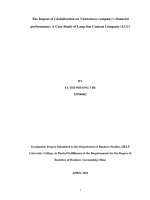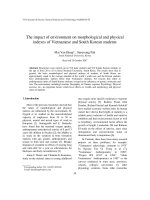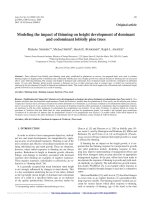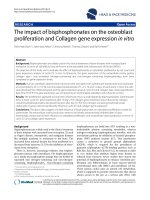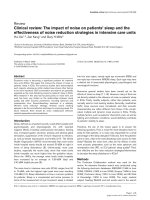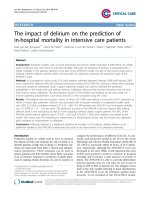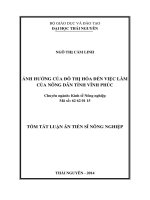The impact of factors on credit risk management in kien long bank vung tau branch (tt)
Bạn đang xem bản rút gọn của tài liệu. Xem và tải ngay bản đầy đủ của tài liệu tại đây (179.2 KB, 2 trang )
ISSN No:-2456-2165
The Impact of Factors on Credit Risk Management in
Kien Long Bank - Vung Tau Branch
Lê Sĩ Trí, Trần Nha Ghi, Nguyễn Thị Phương Anh, Nguyễn Thị Hồng Hạnh
Abstract:- This study was conducted to explore factors
affecting credit risk management in Kien Long Bank,
Vung Tau Branch. With a sample size of 180, the results
shown that there are three factors that influence credit
risk management in Kien Long Bank: Credit Policy (P =
0.238); Customer factor (P = 0.252); Credit rating (p =
0.437).
Key words:- Credit risk management, Kien Long.
I.
INTRODUCTION
In Vietnam, the credit risk management of commercial
banks is concerned, but credit risk management has not been
identified, measured, assessed and controlled accurately,
strict and in accordance with international practice.
Hypothesis H3: objective factor that positively affects credit
risk management.
III.
RESEARCH RESULTS
The results of CFA analysis with the critical
measurement model show statistical significance
X2 [98] = 132 (p = 0.000). Other indicators such as GFI =
0.925; TLI = 0.972; CFI = 0.977; RMSEA = 0.042 <0.80
are satisfy. The CFA weight of all observed variables is
greater than 0.5; Confirm the uniqueness and convergence
values of the scales used in the research model. Thus, the
critical model attains compatibility with market data.
Credit risk management is a very important part of the
Bank's operations, operations and development, not only to
minimize credit risk but also to ensure profitability,
reputation and performance. operating for banks. For the
above reasons, the study of factors affecting the credit risk
management at Kien Long Commercial Joint Stock
Bank - Vung Tau Branch is very necessary.
II.
MODEL AND HYPOTHESIS OF RESEARCH
Based on the qualitative research results of 5 experts in
banking field, the proposed model and hypothesis of
research at Kien Long Bank, Vung Tau Branch is shown in
Figure 1.
Fig 1: - The proposed research model
Hypothesis H1: Credit policy has a positive impact on credit
risk management
Hypothesis H2: Credit rating has a positive impact on credit
risk management
Hypothesis H3: Customer factors affect positive credit risk
management
The SEM results (Figure 3) of the theoretical model
have x2 [159] = 290.96; p = 0.000;
CMIN / df = 1.830 <2; GFI = 0.870; TLI = 0.919; CFI =
0.933; RMSEA = 0.068. The Heywood phenomenon does
not appear in the SEM estimation process so the model fits
into the market data.
ISSN No:-2456-2165
Relationships
QTRR
QTRR
QTRR
Qt r r
<—
<—
<--<—
CS
XH
KQ
KH
B
0.219
0.45
0.065
0.267
Estimate
S.E.
0.075
0.093
0.071
0.081
Table 1. SEM result
Note: B: unstandardized coefficient, P: standardized
coefficient; S.E: standard deviation
The results of key parameters estimation are presented
in Table 1. Credit policy has a positive impact on credit risk
management (P = 0.238; p = 0.003). Next, the credit rating
positively affects credit risk management (P = 0.437; p =
0.000). Finally, the customer factor has a positive influence
on credit risk management (P = 0.267; p = 0.001).
Objectivity does not affect credit risk management.
IV.
CONCLUSION
The proposed study model consists of four factors that
influence the credit risk management. The results of the
measurement models show that the scale values are reliable
(Cronbach's Alpha coefficient, composite reliability) and
allowable values
(unidirectional,
covariance, and
distinguish).
This study demonstrated a positive relationship
between factors such as credit policy, credit ratings, and
customer factors that positively affect credit risk
management.
REFERENCES
[1] . Hoàng Trọng & Nguyễn Chu Mộng Ngọc (2005).
Phân tích dữ liệu nghiên cứu với SPSS. Hà Nội: NXB
Thống Kê.
[2] . Nguyễn Đình Thọ (2011). Phương pháp nghiên cứu
khoa học trong kinh doanh. Hà Nội: NXB Lao Động Xã
Hội.
P
0.238
0.437
0.068
0.252
t
P-value
2.934
4.839
0.915
3.278
0.003
***
0.360
0.001

